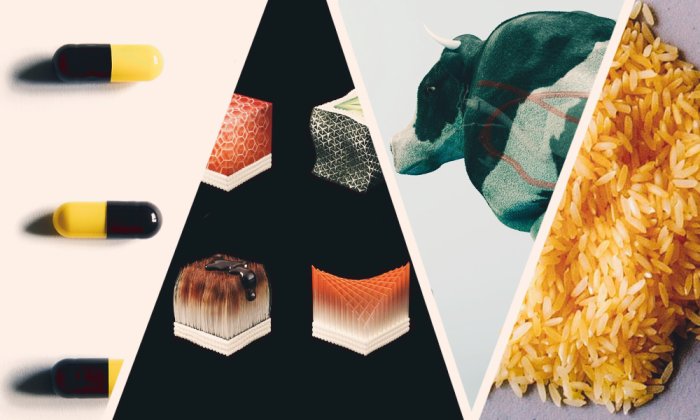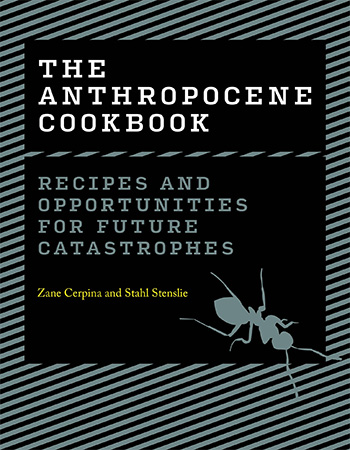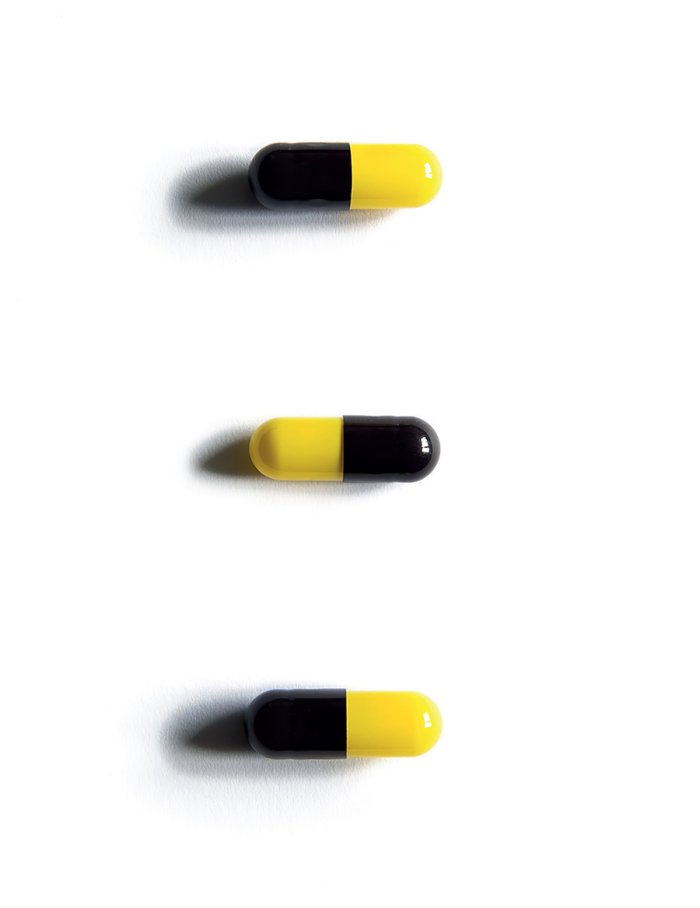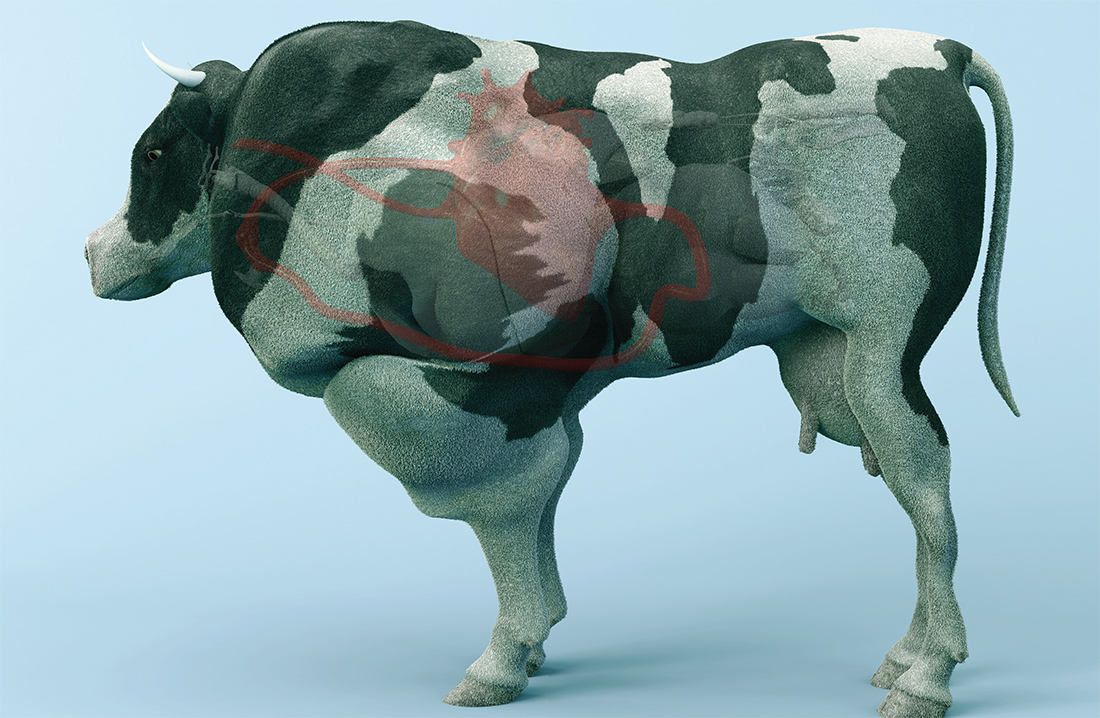Superfoods of the Future, From Cockroach Milk to DNA-Personalized Meals

Living without hunger, with nutritious and tasty food in abundance, is probably our oldest and most universal dream. Ancient Greeks told legends about ambrosia, the gods’ mythical food that provided immortality to anyone who consumed it. The Greek poet Homer wrote about fruits that were produced without the need for farming. And the medieval fantasyland Cockaigne portrayed tasty dishes that reproduced by themselves, flowed down rivers, and fell from the skies with no effort. Centuries later, thanks in great part to a deep-pocketed food industry, we haven’t stopped searching for the one and true “superfood.” Here, we offer a glimpse of how this long-awaited superfood of the future might look.
Cockroach Milk
The search for the ultimate superfood has led to some truly wild scientific studies and speculations about food futures, even if the food in question is of natural origin. A research paper from 2018 speculated that the next superfood might be something quite unexpected — cockroach milk. According to the article, the cockroach species Diploptera functata has evolved the trait of viviparity: It can provide nutrients to developing embryos during the gestation period. It produces a substance that contains protein crystals claimed to be more nutritious than any animal milk. Even if cockroach milk was more nutritious than cow’s milk, one question remains: how to milk a cockroach?

The scientist and researcher Leonard Chavas claims that the process is energy-intensive and time-consuming. While the method itself is relatively easy, the milk-like substance can be harvested only at the stage of the cockroach’s lifespan when it begins to lactate for its offspring. Unlike cows, the cockroach has to be killed in order to extract the milk crystals from its midgut. He speculates that milking just a couple of cockroaches is likely to take half a day. If the estimation is correct, you would need to kill a thousand cockroaches to obtain only three and a half ounces of the product.
Even if cockroach milk is the ultimate superfood and contains four times more protein than cow’s milk, it is unlikely to appear on supermarket shelves in the future. While the promise of cockroach milk has taken public debate by storm, in reality, large-scale production is likely to be both unsustainable and insufficient. It might be easier to drink four times more cow’s milk to gain the same energy and protein value.
Meal in a Pill
Nature holds many potential superfoods, but in the Anthropocene, sustaining the world solely on foods of natural origin will be just as problematic as feeding everyone with cockroach milk. When nature as we know it changes (at best) or disappears (at worst), a future superfood is likely to be produced synthetically, a recurring theme in science fiction.

The most popular staple food of sci-fi, and perhaps the ultimate techno-utopian fantasy, is the meal in a pill. According to food researcher and writer Warren James Belasco, our fascination with the meal in a pill goes back to the Neolithic age. Once humans started domesticating grains and legumes, they saw them as minute foods with immense powers. A single seed or a single grain can produce a large amount of food. Therefore, each becomes enormously important. Belasco also draws parallels to charms and gems that in folklore possess magical qualities despite their miniaturization. Similarly, the meal in a pill promises a comfortable and almost magical fix to the most timeless and universal human problem — the struggle for food.
Early speculations on the meal-in-a-pill concept date back to the 1880s. In the satirical novel “The Republic of the Future” (1887), for example, American writer Anna Bowman Dodd describes New York in the year 2050, where food tablets are delivered directly to apartments. Dodd explains that the food pills freed women of the future from working in the kitchen: “When the last pie was made into the first pellet, women’s true freedom began.”
In 1894, chemist Marcellin Berthelot predicted that in the year 2000, humans would eat synthetic food in the form of a tablet.
But the concept of a meal in a pill did not originate simply out of frustrations with the labor-intensive process of cooking. The science-based claims in favor of this concept were already laid down in the 1890s. In 1894, chemist Marcellin Berthelot predicted that in the year 2000, humans would eat synthetic food in the form of a tablet. He believed that traditional staple foods would no longer be grown naturally but would be manufactured using synthetic chemistry from carbon, hydrogen, oxygen, and nitrogen.
While many foods today are produced using synthetic ingredients, full meal-replacement pills are nowhere in sight. Scientists are still working on a way to fit all the nutritional and caloric needs into one standardized capsule. It is estimated that with current knowledge and technologies, we would have to consume more than 450 pills a day to gain the necessary nutritional intake. For now, a meal in a pill remains a distant dream of rendering mankind independent of nature’s resources and potential failures.
Golden Rice and Other Silver Bullets
While the reductionist approach to feed the world continues to gain its appeal, we more frequently choose to supersize and superupgrade already existing food sources. Genetic modification techniques are often applied in this quest to enhance our favorite staples. The idea of modifying a food source to reach its full potential also leads to a promise of easy fixes and absolute solutions for increasing food security on a global level. The result is highly debated genetically upgraded foods (genetically modified organisms, or GMOs), which are hailed for their enormous potential to increase food security and criticized as magical solutions (that is, silver bullets) to complicated food security issues.
Arguably the most controversial and publicly debated silver bullet project is golden rice — a genetically engineered type of Asian rice (Oryza sativa) that can biosynthesize beta-carotene that is metabolized into vitamin A in the human body. The idea to genetically boost the rice plant was born in the 1990s as a solution for ending vitamin A deficiency and minimizing malnutrition, especially in developing countries. As rice is regularly consumed by more than half of the global population, it is speculated that golden rice could have a significant impact on food security on a global scale.
The silver bullet approach has also been applied to other plants, including the potato (Solanum tuberosum L.). Using techniques similar to those used to produce golden rice, researchers could enhance the potato with provitamin A and vitamin D, resulting in a golden potato. If successful, it could increase food security and help tackle preventable childhood blindness and other illnesses, especially in countries where the potato is already an important staple. While the debates continue about GMO use in agriculture, we are likely to see, according to the Golden Rice Humanitarian Board, “neither high folate rice, nor high iron rice, nor high zinc rice, nor Golden Rice” tested to their full potential as superfoods.
Supersizing Food
The broiler chicken has become a major symbol of human abilities to engineer, supersize, mass-produce, and turn a chosen species into a global staple food. Does this mean humans have modified the chicken into a superfood?

The human role in the development of the modern broiler chicken is thoughtfully explored by artist Andreas Greiner in his 2019 work “Monument for the 308.” Greiner confronts the audience with a large sculpture of a broiler chicken in the size of a dinosaur. It is a 3D-printed sculpture based on a high-definition computerized tomography (CT) scan of a dead Ross 308 chicken, a common breed of broiler bird. In comparison to its prehistoric ancestor, the bird-like dinosaur Archaeopteryx, the Ross 308 chicken is not extinct, and it has never been bigger in its individual size or in its popularity in the global population. However, the bird can no longer survive without humans. Therefore, Greiner’s monumental work, which resembles a typical dinosaur displayed in a national history museum, “acknowledges the reciprocal dependency between this animal and humans.”
The work represents how humans have manipulated the chicken’s anatomy to serve increasing levels of global meat consumption. If the modern chicken is more of a genetically engineered product than a naturally occurring superfood, what further transformations will this bird undergo in the future? What will be the next upgrade to our industrially farmed animals?
Redesigning Farm Animals
As long as industrial farming exists, it has enormous negative environmental effects on carbon emissions and energy, water, and land overuse. If humans are to continue farming animals for meat and milk in the Anthropocene, the industry must be radically reinvented. The answer to sustainable industrial farming in the future might be simply using farm animals for the production of more than just meat and dairy.
“The Cow of Tomorrow” is inspired by scientific research exploring the feasibility of harvesting electric power using a miniature hydrodynamic turbine powered by the cardiac output flow.
In his 2015 project “The Cow of Tomorrow,” artist Paul Gong creates a future scenario where already heavily redesigned farm animals can be further modified for energy production. Gong proposes implementing a tiny turbine in the artery of the cow, allowing it to use the blood flow to harness energy. According to Gong, the cow is a perfect candidate due to its long history of industrial domestication. Since we have already genetically modified the cow to enhance its milk yield, why not look into new tasks the animal could possibly do? While “The Cow of Tomorrow” might look like merely thought-provoking speculation, it is inspired by scientific research exploring the technical feasibility of harvesting electric power using a miniature hydrodynamic turbine powered by the cardiac output flow in a peripheral artery.

The artist created the project to look at the question of whether it would be for the better or worse to further increase human control over nature through the use of emerging technologies. The ongoing pursuit of genetically engineered superanimals and superplants brings up many ethical and moral questions, of course. Is there a limit to how far other species should be transformed to benefit human survival? Would creating multipurpose farm animals be unethical if it contributed to sustainability? What would be the environmental benefits of upgrading the cow into a powerhouse? Could the energy harvested from farm animals be used to power the farming industry? In theory, such concepts could help make the resource-intensive industry more self-sufficient. A smart use of existing foods and innovations in biotechnologies can lead to our future superfoods being more than just a source of nutrition.
Unconventional Superfoods: Spirulina
Genetically modified superfoods are not the only foods that humans are skeptical about. Even with the modern trend of superfoods, only a few have become widely popular. How will we know what to choose in the Anthropocene? Many have tried the trending ancient superfoods such as quinoa and amaranth, which was a staple for Aztecs. Also, goji berries, which were used in ancient Chinese medicine, seem to have become a culturally accepted snack. While these foods are unlikely to hold any more nutritional value than other alternatives, there is another ancient superfood that has been praised for its potential in diets after the ecological crisis — algae.
Spirulina platensis (also known as Arthrospira) is a genus of cyanobacteria currently gaining global interest as a potential future superfood. Until the 16th century, it was used as food by the Aztecs and other Mesoamericans. Today, many African countries still use it as a major protein source by harvesting it from natural waters, drying it, and then eating it.
Dried spirulina holds up to 70 percent proteins, which is half more than soybeans. It also contains various vitamins and minerals and is considered one of the most nutritious foods on the planet. Because of its rich composition, the United Nations World Food Conference declared it in 1974 to be the best food for the future. Spirulina is also likely to withstand uncertain climate futures as it can be cultivated in rather barren areas, does not need clean fresh water, and will gladly grow in highly saline water instead.
Speculation on alternative ways of eating this superfood in the far future is explored by artists Michael Burton and Michiko Nitta in the 2010 project “Algaculture.” “Algaculture” is a speculative future scenario that proposes enhancing humans with new bodily organs populated by algae. This unique symbiotic relationship would allow humans to be semiphotosynthetic. Some organisms are known to enter a coexistence with entities that perform photosynthesis. The pea aphid (Acyrthosiphon pisum), for example, is an insect that uses pigments to capture sunlight and transfer it within its cells for energy production. And the sea slug Elysia chlorotica eats algal cells to enable photosynthesis. It can sufficiently sustain itself on carbon energy for several months. Could humans possibly follow this blueprint of sustainable and self-sufficient feeding? How would a symbiotic human-spirulina relationship change the way we feed ourselves in the future?
As proposed in “Algaculture,” implementing algae within the human organ system would, in theory, enable humans to carry and produce nutritious food anywhere, even without the need for algae farms. While the project is highly speculative, it also poses the intriguing idea of a closed-loop system based on organic and natural means. Instead of upgrading our foods or developing synthetic food substitutes, we can directly use genetic engineering to transform our bodies and the way we eat.
In the future, personalized nutrition could become as common as precision medicine.
Initially, species of algae look like the perfect superfood for the future, especially in the Anthropocene. However, these organisms are not fully compatible with the human body as food. In 2016, Soylent had to recall products that contained a novel ingredient — Chlorella protothecoides algal flour — due to the allergic reaction it caused in several customers.
Several reported side effects raised the alarm about the safety of using microalgae such as spirulina and Chlorella protothecoides on a frequent basis. Spirulina is also a cyanobacterium, which has been found to produce toxins. The documented health issues include allergies, nausea, and vomiting. Prolonged consumption of concentrated spirulina in the form of tablets could possibly cause irreversible damage to some organs, including the kidneys and the liver. It is also believed that there are still many compounds that have not yet been discovered and properly tested in microalgae. Choosing the perfect superfood is no easy task, but what if you knew by design exactly what to eat?
DNA-Personalized Superfoods
It might be impossible to produce one standardized superfood providing all the necessary nutritional and medicinal properties to all equally. Instead of looking for just one, could we develop personalized foods that entirely match each individual’s needs?
An early inspiration for personalized cuisine can be found in the original series of the show “Star Trek”(1966–1969), where food was created using a Food Synthesizer — a device that turned different raw materials into edible organic matter. The food synthesizer was able to make a variety of foods with any taste. Later, “Star Trek: The Next Generation” (1987–1994) envisioned the Replicator, an upgraded next-generation device that was preprogrammed to make 4,500 different types of food using a molecular matrix. If it is possible to produce a variety of foods from a few basic ingredients, could we also print superfoods? And if future superfoods are based on data recipes, could we even individualize our food on a personal level?
We are still in the early stages of understanding the relationship between the human genome, nutrition, and health. But some nutritionists have already begun to use genomics tests to create individual assessments, and in the future, personalized nutrition could become as common as precision medicine. Companies specializing in genetic testing also offer their clients customized health recommendations based on saliva, blood, and fecal samples. It is now possible to construct meal plans, food supplement packs, and weight-loss recommendations based on individual data. How would the future of the food industry look if ordering the perfect meal was possible through personalized assessment — and if making that meal was as simple as pressing a button on a Food Synthesizer like the one on “Star Trek”?
The Japanese design studio Open Meals explores hyperpersonalization in the food industry through its restaurant concept Sushi Singularity. Set to open in Tokyo, Sushi Singularity will apparently serve personalized food based on the guests’ individual health identification (HID). Prior to the restaurant visit, guests will receive a test kit for obtaining their HID through DNA, urine, and intestinal tests. The restaurant promises to serve hyperpersonalized sushi dishes fitting each person’s individual nutritional needs. Beyond individual nutritional requirements, the future of personalized superfood could in theory be further customized according to environmental conditions and the availability of local resources.
Future superfoods will have to fulfill many projections. They should provide health benefits for people, contribute to the survival of the species, enhance our eating experiences, and set a new course for the relationship between humans and nature. While classic superfoods (such as the meal in a pill) remain a dream of science fiction, new bizarre solutions emerge, even if many of them (including cockroach milk) are unlikely to be produced in large enough quantities to impact our diet.
This much is undeniable: A large flood of probable catastrophes looms over us in the age of the Anthropocene — the Age of Man. In this new geological epoch, it is we humans who are reshaping the planet, impacting geology and ecosystems alike. The number of self-inflicted doomsday scenarios grows by the day, confronting us with an endless chain of world-ending armageddons. No wonder the end of humanity appears nigh. Or? This coming era can also be seen as an opportunity for change, new ideas, and a constructive future. We must seize the sizzling moments that lie ahead of us. The Anthropocene will put our thinking, creativity, and ingenuity to the test. Let us welcome that and throw ourselves headfirst into the waves of change.
Zane Cerpina is a curator and writer working within experimental and digital arts.
Stahl Stenslie is a curator and researcher specializing in experimental and emerging aesthetics and disruptive technologies who has held positions at Academy of Media Arts Cologne, Oslo National Academy of the Arts, and Aalborg University.
Cerpina and Stenslie are the authors of “The Anthropocene Cookbook: Recipes and Opportunities for Future Catastrophes,” from which this article is adapted.